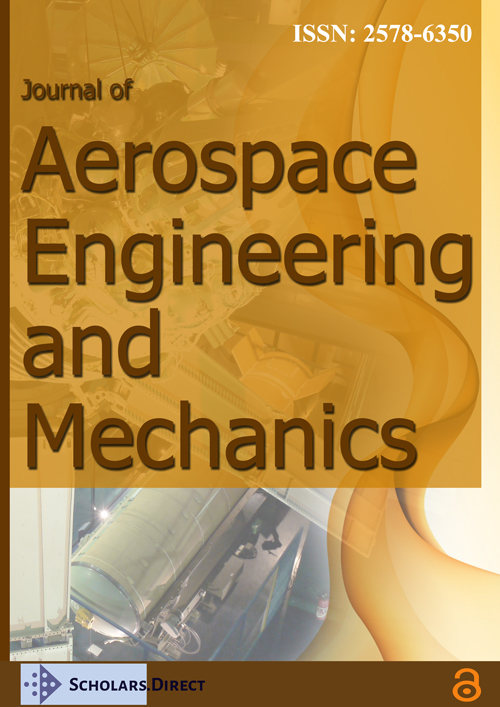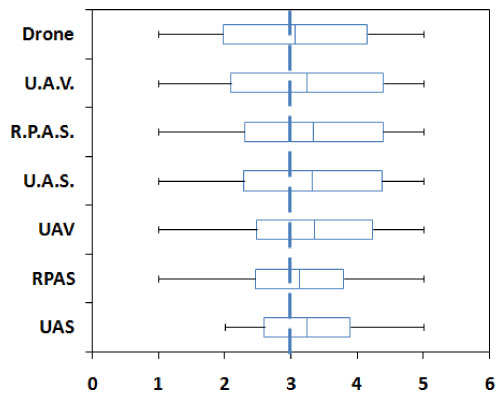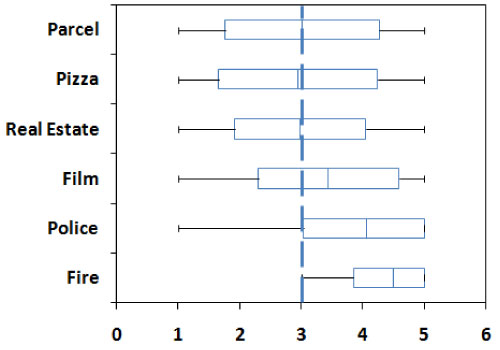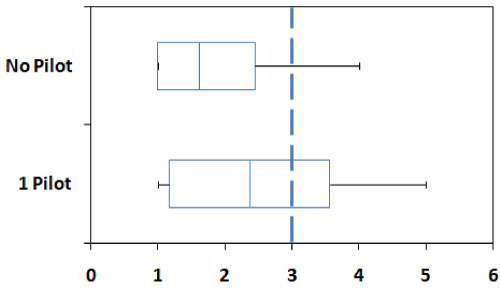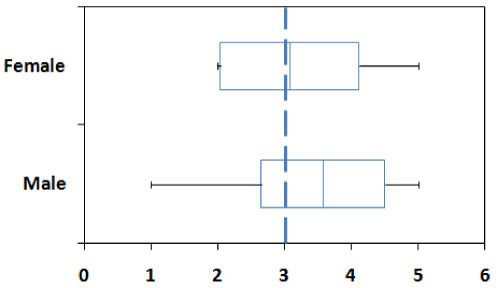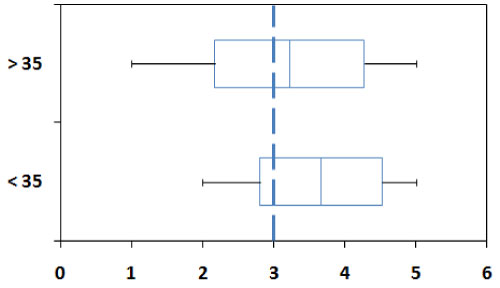Public Perception of Drones… or Should that be Remotely Piloted Aircraft Systems?
Abstract
The media coverage of remotely piloted aircraft systems (RPAS) has highlighted some issues, particularly in terms of security and privacy concerns. As such, it is essential to understand the public's perception towards these systems. The purpose of this study was to assess the public's perception towards 1) The terminology used to define RPAS, which varies across the industry; 2) The applications, current and future, of RPAS; 3) The future of passenger transport involving RPAS, and 4) RPAS in general. It was found that there was little difference between the "terms" used to describe RPAS; however, there was a significant difference at the 90% confidence level for "remotely piloted aircraft systems" over "drones". In terms of RPAS applications, community based applications had a positive perception, while personal applications were neutral. The implementation of RPAS into passenger transport aircraft was strongly negative. Finally, there was an overall positive perception towards RPAS.
Keyword
Autonomous vehicles, Computers and society, Privacy, Social issues
Introduction
Drones are commonly thought of as military assets which brings to mind the launching of Hellfire missiles from Predator UAVs [1]. In fact, this premise has recently been popularized in feature films such as Good Kill [2] and Eye in the Sky [3]. But the term drone, intimately associated with military applications, has not been adopted by the International Civil Aviation Organisation (ICAO). The official term utilized by ICAO is Remotely Piloted Aircraft System (RPAS) [4]. Other initialisms are also used to describe these aircraft, including unmanned aerial vehicles (UAVs) and unmanned aerial systems (UASs).
In terms of civil RPAS, there is an expected growth from approximately $1.41 billion (USD) in 2017 to almost $180 billion (USD) by the end of 2025 [5]. Since RPAS are therefore an emerging pervasive technology, the impact they have on society and individuals needs to be assessed. To that end, a preliminary pilot study has been undertaken to investigate the public's perception of RPAS. Further work will expand on the public's perception in a second stage, refined by the outcomes of this first stage. This will then be followed by a study of "regular" pilot's perceptions towards RPAS, investigating aspects such as shared airspace etc. An extensive body of literature already exists on the perspective of regulators, across multiple countries [6] which effectively assesses the perception of regulators.
As previously mentioned, there are a number of "terms" used when discussing RPAS. Therefore, one of the goals of this public survey was to assess the reaction to the various "terms", as alluded to in the title of the paper. In addition to this, the public's perception to various RPAS applications was also assessed; that is, to determine how positively the public feels about the application of RPAS to firefighting etc. The public's perception of future single-pilot and pilotless passenger aircraft was also investigated. Finally, the overall perception of RPAS was assessed in terms of the different demographic groups identified.
Background
"Drones" recently celebrated their 100th birthday, based on the radio controlled heavier-than-air aerial torpedo from 1917 [7]. In fact, it could be argued that the history of unmanned aviation is the history of "drones", including rockets, balloons, and kites from hundreds/thousands of years ago [8]. When these other prospects are included, the first radio controlled aircraft were in fact balloons in the late 1800's [9].
Military RPAS have been identified to fill a variety of roles. These have previously been defined as [10]:
• Tactical UAVs: divisional level - reconnaissance, surveillance, target acquisition,
• MALE and HALE strategic UAVs,
• Tactical UAVs: regimental/brigade level - (additional roles) threat detection, communications,
• Vertical take-off and landing UAVs - naval applications, electronic warfare, psy-ops against civilians,
• Offensive UAVs - such as cruise missiles,
• Armed UAVs,
• Lighter-than-air UAVs,
• Micro Air Vehicles MAVs,
• LALE,
• Optionally piloted aircraft, and
• UCAVs.
The first armed UAV which actively killed a target was a Predator equipped with Hellfire missile in 2001 [11]. Due to the unit cost, the current military market for RPAS is greater than the civil market, worth approximately $9.6 billion (USD) in 2018 [12]. The military market was estimated to grow such that by 2027 there is a projected total market value at that time of over US$80 billion [12]. So the non-military market of RPAS will eventually outpace the military market.
Today, the applications of RPAS in non-military settings are diverse. These include [13]: traffic monitoring, volcanography, firefighting, maritime observation, and wildlife monitoring. In addition to this, RPAS are used in precision agriculture [14], mapping [15], civil engineering [16], and law enforcement [17], as well as search and rescue, filmmaking, demining, and scientific research [18]. One of the most anticipated applications (discussed extensively in the news media, trade publications, and academic journals) is the advent of package delivery by RPAS, such as Amazon Prime Air [19], and even for general mail delivery [20].
Approach
Survey
The survey was conducted at RMIT University Open Day, on a Sunday when the campus was open to the public. It should be noted that the survey was conducted on the street, and the campus is in fact 6% of the Melbourne central business district. As such, participation was open to the general public, with diverse demographics collected. One hundred paper surveys were distributed and collected, of which 83 were completed correctly. Mistakes were made, some with multiple options selected etc; these responses were omitted.
The questionnaire for the survey consisted of two parts. The first part was four demographic questions (age, gender, education level, and occupation). The second part was four multipoint questions. The first of these was the question regarding perception towards the various "terms":
• UAS,
• RPAS,
• UAV,
• Unmanned Aerial Systems,
• Remotely Piloted Aircraft Systems,
• Unmanned Aerial Vehicles, and
• Drones.
Note that the "terms" were presented in the exact order listed, noting that the participant information and consent information clearly identified the survey was about remotely piloted aircraft and the publics perception towards them. Following this was a question regarding perception towards the application of RPAS, including:
• Firefighting,
• Policing,
• Filmmaking,
• Real estate,
• Pizza delivery, and
• Parcel delivery.
Once again, the applications were listed in this order, and the first four were presented as current applications, and the final two were presented as future applications. The next question asked about the respondent's perception towards being a passenger onboard a commercial airline flight with a) A single pilot onboard and a remote pilot external to the aircraft, and b) No pilot onboard the aircraft with the entire flight crew located remotely. The final question asked about the respondent's overall perception towards remotely piloted aircraft.
The survey instrument, or questionnaire, was constructed using a five point Likert scale for each question. The five point scale was very negative, negative, neutral, positive, and very positive. The questions were phrased as statements about the respondent's perceived feelings towards the construct being assessed.
Analysis
The first step in the analysis was to test if the responses received were normal or not. That is, to assess if the perception measured by the survey was average, below average, or above average. To test for normality a z-test was utilized. The z-score for the z-test is given by,
Here, is the measured average, μ is the expected average (3 for a 5 point Likert scale from 1 to 5), σ is the measured standard deviation, and n is the number of samples. The corresponding statistical hypotheses that are associated with the z-test are,
• H0: = μ
• HA: ≠ μ
That is, the null hypothesis (H0) states that the sample mean is not different to the expected mean, and the alternative hypothesis (HA) statesthat the sample mean is different to the expected mean.
In addition to the z-test, which compares the measured mean to the expected mean, a comparison between means was also necessary. This required a t-test, and based on the fact that responses were tested across questions, with the same respondents, for various demographics, a paired t-test was used. The t-statistic for the t-test is given by,
The corresponding statistical hypotheses that are associated with the t-test are,
• H0: =
• H0: <
That is, the null hypothesis (H0) states that the sample means are not different, and the alternative hypothesis (HA) states that the sample mean 1 is less than sample mean 2. The t-test is therefore one tailed.
Findings
Terminology
The results showing the public's perception of the different "terms" which can be used to describe RPAS are summarized in Figure 1. This shows a box and whisker plot highlighting the mean for each "term", with the box showing one standard deviation, and the whiskers showing the range. The expected mean is also shown in Figure 1, as a dashed line at the value of 3. All of the means can be clearly seen as greater than the expected average. The maximum mean corresponded to "remotely piloted aircraft systems". The minimum mean corresponded to "drones". All of these "terms" were tested to see if the difference to the mean was statistically significant, using the z-test. These results are shown in Table 1. It is clear that the only result which is not significant is for the term "drone", all of the others show a statistical significant difference, being greater than the expected average of 3 (although RPAS is 94% significant, while all of the others are more than 95% significant). Next the most positive and least positive "terms", "remotely piloted aircraft system" and "drones", respectively, were compared using a paired t-test. The corresponding p-value was 0.08. That is, there is a moderate claim to state that the "term" "remotely piloted aircraft system" is perceived better than the term "drone", at the 90% significance level (92% to two significant figures).
It should be noted that as part of the survey, no follow-up open-ended questions were asked to enable an understanding of "why". There are two possible reasons why "drone" would be the least favorable term, which are the two ways the term is most commonly used; the first is the association of the term with military systems, and the second is the association with toys. The fact that the full term "remotely piloted aircraft system" is preferred is likely due to the reason ICAO selected the term, it indicates a pilot is controlling an aircraft, albeit remotely.
Application
The public's perception towards the applications of RPAS, current and future, are shown in Figure 2. Note that for the first application, firefighting, none of the responses are negative, as illustrated by the fact the entire box and whisker plot is above the expected mean line drawn at the value 3. The second application, policing, is also significant with the box being above the expected mean value line. The use of RPAS in filmmaking is positive, while the last current application, real estate, is neutral. We also note that both of the two popular proposed future applications, parcel and pizza delivery, are also both neutral. These observations are supported by the z-tests as seen in Table 2. The p-values for the first three are significantly greater than 99%. That is, there is an overwhelmingly positive view towards these applications. The second group of three (real estate, pizza delivery, and parcel delivery) are clearly neutral.
Airline RPAS
Figure 3 shows the comparative perception of the public towards reduced flight crew in airline travel. The question was explicitly framed around the respondent as a passenger on an aircraft with a pilot onboard and a co-pilot on the ground, and then in the second part, both flight crew members located on the ground. As is clearly indicated in the plot, both questions elicited a negative response, where the "no pilot" case resulted in a significantly negative response with the entire box located below the expected mean value of 3. Although not asked (an acknowledged flaw with this pilot study), it would be fair to assume that the comparative value for a two-crew onboard question would in fact be higher than neutral. The z-test results highlight the strength of the negative sentiment, with both values far more that 99% significant. A paired t-test was also used to compare these two questions. The result was a p-value much less the 0.01, and hence it can be concluded that the public's perception towards a pilotless passenger aircraft is significantly more negative than their perception towards a single pilot passenger aircraft.
Overall feelings
Finally the overall perception of the public towards RPAS in general was assessed. This single question was broken down into pairs based on three of the four demographics collected. It should be noted that the array of occupations was extremely diverse with no trend or significant clustering, and hence no statistical inference could be drawn utilizing this demographic. The three demographics utilized were, gender (shown in Figure 4), age (shown in Figure 5), and education level. Age was split into "young" and "old", or more correctly, respondents 34 and under, and respondents 35 and over. Education level was split into those with a degree or higher, and those without. These divisions closely split the sample in half with a logical justification. The results for the education level were statistically insignificant, and the box and whisker plots were almost identical. The associated unpaired t-test to compare respondents with a degree to those without a degree gave a p-value of 0.8. As such, it can be concluded that education level does not influence a person's perception towards RPAS, nor would it be expected to (Table 3).
From Figure 4 we can clearly see that males have a more positive perception towards RPAS than females, while neither of the two means is negative. A t-test was then used to determine if the observation was statistically significant. The corresponding p-value was 0.0471. As such, we can reject the null hypothesis and state that males have a more positive perception towards RPAS compared to females, at the 95% confidence level.
A similar trend for age is also shown when looking at Figure 5. It can be seen that "younger" respondents have a more positive perception of RPAS relative to "older" respondents. Both of the means are still above average. To determine if this observation is statistically significant an unpaired t-test was utilized. The corresponding p-value was 0.035. Therefore, at the 95% confidence level, "younger" people have a more positive perception towards RPAS compared to "older" people.
Contextualisation
The results of this study are comparable to other related studies. Previous work asking the public's perception about risks associated with RPAS gave mixed results [21]. Some results showed the risks associated with RPAS were more acceptable than those associated with drones, while in general the risks were comparable, with unmanned perceived as less risky than both, but then the acceptability of the risks associated with unmanned aircraft were the lowest. The main issue in comparing this study with that work, is that the samples of 100 respondents were independent. While here, we use dependent samples, so we are more confident of the rankings given that all the respondents assessed all labels.
It should be noted that the term RPAS is not commonly used in the US, and surveys conducted there have omitted this term completely [22]. Other work [23], has surveyed the general public about "drones", and their acceptability. However, the confounding influence the use of this term has on the survey responses needs to be assessed. That is, would the respondents have found remotely piloted aircraft technology more useful than drone technology?
Conclusion
The public's perception of the "terms" used to describe RPAS shows no great difference. There is a slight improvement in perception when the full "term" is used in place of an initialism, and although "drone" had the worst perception, this was not negative. Also, "remotely piloted aircraft system" had the best perception, and there was a statistical difference between the two at the 90% confidence level, but not at the 95% confidence level. Interestingly when comparing "RPAS" with "remotely piloted aircraft system", there was also a statistical significance between the two at the 90% confidence level, but not the 95% confidence level. As ICAO has officially adopted the "term" "RPAS", the slightly less positive perception of this "term" (while still above the expected average), suggests that public awareness of "RPAS" should be improved. Another interesting conclusion to draw is that using initialisms or acronyms should be avoided. So if a business were to market RPAS, either in terms of a product or application, clear terminology should be utilized.
When used for helpful and noninvasive applications, the public's perception of RPAS is overly positive. This was especially significant for the use of RPAS in firefighting situations, where all responses were non-negative. There is a wider spread of data for policing applications; from very negative to very positive, which is understandable in terms of people's diverse perception of civil liberties. Also of interest is the fact that the perception of implementing RPAS into everyday situations is neutral. This is interesting for two reasons, a great deal of effort is being invested into services such as pizza delivery [24], and there have been some notable negative situations involving the use of RPAS in real estate [25].
When used for helpful and noninvasive applications, the public's perception of RPAS is overly positive. This was especially significant for the use of RPAS in firefighting situations, where all responses were non-negative. There is a wider spread of data for policing applications; from very negative to very positive, which is understandable in terms of people's diverse perception of civil liberties. Also of interest is the fact that the perception of implementing RPAS into everyday situations is neutral. This is interesting for two reasons, a great deal of effort is being invested into services such as pizza delivery [24], and there have been some notable negative situations involving the use of RPAS in real estate [25].
Acknowledgment
The assistance of Matthew Lamont, a graduate of RMIT University needs to be acknowledged. He collected the raw data used in the pilot study.
References
- Callam A (2015) Drone wars: Armed unmanned aerial vehicles. International Affairs Review 18.
- Niccol A (2015) Good kill. IFC Films, 102 minutes.
- Hood G (2015) Eye in the sky. Entertainment One, 102 minutes.
- (2015) Manual on remotely piloted aircraft systems. (1st edn), International Civil Aviation Organisation, Canada.
- Costello H (2018) Global smart commercial drones market. Orbis Research, Dallas, TX.
- Morales AC, Paez D, Arango C (2015) Multi-criteria analysis of UAVs regulations in 6 countries using the analytical hierarchical process and expert knowledge. International Archives of the Photogrammetry, Remote Sensing & Spatial Information Sciences 40: 175-181.
- Nichols CP (2014) Drones: The coming of age of a not-so-new technology. The Judges' Journal 53: 20.
- Curley R (2011) The complete history of aviation: From ballooning to supersonic flight. Rosen Education Service, USA.
- Boddington D (2004) Radio-controlled model aircraft. Crowood Press, Limited.
- Blyenburgh PV (1999) Current and future UAV military users and applications. Air & Space Europe 1: 51-58.
- Khurshid J, Hong BR (2004) Military robots - a glimpse from today and tomorrow. ICARCV 2004 8th Control, Automation, Robotics and Vision Conference.
- Smith C (2019) Military drone market. Acute Market Reports, San Jose, CA.
- Valavanis KP, Vachtsevanos GJ (2014) Handbook of Unmanned Aerial Vehicles. Springer Netherlands.
- Woldt W, Frew E, Meyer G (2014) Feeding a hungry world: the potential for unmanned aircraft systems. XRDS 20: 24-27.
- Nex F, Remondino F (2013) UAV for 3D mapping applications: a review. Applied Geomatics 6: 1-15.
- Liu P, Chen A, Huang Y, et al. (2014) A review of rotorcraft unmanned aerial vehicle (UAV) developments and applications in civil engineering. Smart Struct Syst 13: 1065-1094.
- Murphy DW, Cycon J (1999) Applications for mini VTOL UAV for law enforcement. Proceedings of the SPIE 3577: 35-43.
- Kosme SM, Sen PK, Sahu G (2015) A Review on Unmanned Aerial Vehicle (UAV). International Journal of Research in Advent Technology 3: 18-22.
- D'Andrea R (2014) Guest editorial can drones deliver? Automation Science and Engineering, IEEE Transactions on 11: 647-648.
- Borščová D, Draganová K (2014) Utilization possibilities of unmanned aerial systems in postal and parcel services. Acta Avionica 16.
- Clothier RA, Greer DA, Greer DG, et al. (2015) Risk perception and the public acceptance of drones. Risk Analysis 35: 1167-1183.
- PytlikZillig LM, Duncan B, Elbaum S, et al. (2018) A drone by any other name: Purposes, end-user trustworthiness, and framing, but not terminology, affect public support for drones. IEEE Technology and Society Magazine 37: 80-91.
- Lidynia C, Philipsen R, Ziefle M (2016) Droning on about drones—acceptance of and perceived barriers to drones in civil usage contexts. Cham 317-329.
- Rutkin A (2016) Flight school for robots. New Scientist 229: 21.
- Panahi R (2014) Mt Martha woman snapped sunbaking in g-string by real estate drone. In: Herald Sun, The Herald and Weekly Times, Melbourne.
- Swan WM, Adler N (2006) Aircraft trip cost parameters: A function of stage length and seat capacity.Transportation Research Part E: Logistics and Transportation Review 42: 105-115.
- D. Harris D (2007) A human‐centred design agenda for the development of single crew operated commercial aircraft. Aircraft Engineering and Aerospace Technology 79: 518-526.
- Noor AK, Venneri SL (1994) Future flight. Mechanical Engineering 116: 86.
Corresponding Author
Graham Wild, Air Force Institute of Technology, Nigerian Air Force, Nigeria.
Copyright
© 2019 Jemitola P, et al. This is an open-access article distributed under the terms of the Creative Commons Attribution License, which permits unrestricted use, distribution, and reproduction in any medium, provided the original author and source are credited.

